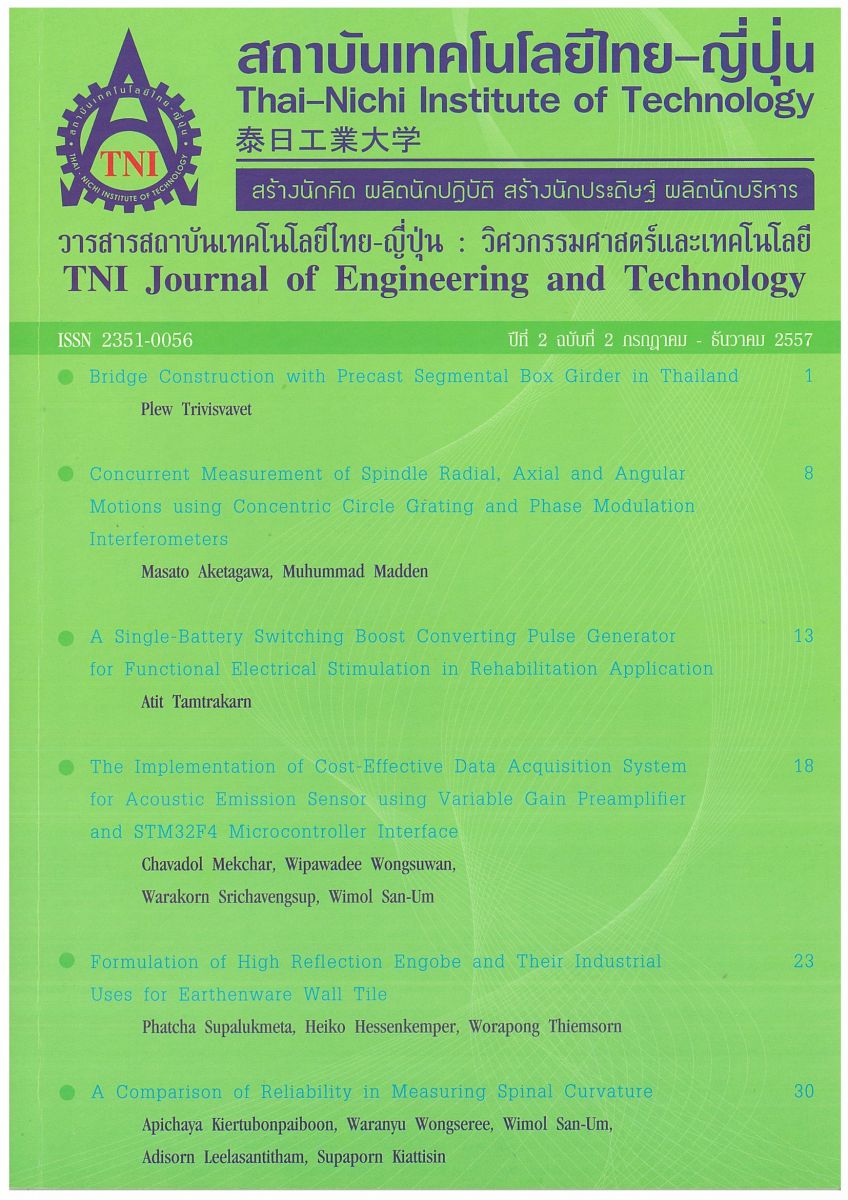A Comparison of Reliability in Measuring Spinal Curvature
Main Article Content
Abstract
The purpose in this study is to assess intra-rater and inter-rater reliability of 3 methods for measuring spinal curvature in 30 anteroposterior radiograph 2D view (AP view) with spinal patients of Lerdsin hospital during the year from 2004 to 2011. Three methods i.e. Cobb, Ferguson and Polynomial are compared with each value in terms of reliability. Ferguson is the traditional method and Cobb is probably the most popular, while polynomial is one of the first documented mathematical models for sagittal spinal curvature. Intraclass correlation coefficient (ICC) is used to calculate the inter-rater reliability (ICC model 2, 1) and intra-rater reliability (ICC model 3, 1). The statistical analysis shows that the intra-rater reliabilities of Ferguson, Cobb and Polynomial are 0.968, 0.950 and 0.910, respectively. In similarity, their inter-rater reliabilities are 0.477, 0.659 and 0.407 respectively. The results indicate that the most reliable measurement of spinal curvature is the Ferguson method. It can be used to assess the measurement with some cautions especially. And the most reliable measurement of spinal curvature is Cobb method, when using between examiners.
Article Details
Article Accepting Policy
The editorial board of Thai-Nichi Institute of Technology is pleased to receive articles from lecturers and experts in the fields of engineering and technology written in Thai or English. The academic work submitted for publication must not be published in any other publication before and must not be under consideration of other journal submissions. Therefore, those interested in participating in the dissemination of work and knowledge can submit their article to the editorial board for further submission to the screening committee to consider publishing in the journal. The articles that can be published include solely research articles. Interested persons can prepare their articles by reviewing recommendations for article authors.
Copyright infringement is solely the responsibility of the author(s) of the article. Articles that have been published must be screened and reviewed for quality from qualified experts approved by the editorial board.
The text that appears within each article published in this research journal is a personal opinion of each author, nothing related to Thai-Nichi Institute of Technology, and other faculty members in the institution in any way. Responsibilities and accuracy for the content of each article are owned by each author. If there is any mistake, each author will be responsible for his/her own article(s).
The editorial board reserves the right not to bring any content, views or comments of articles in the Journal of Thai-Nichi Institute of Technology to publish before receiving permission from the authorized author(s) in writing. The published work is the copyright of the Journal of Thai-Nichi Institute of Technology.
References
J. Dickson and W. Erwin, S. Esses: Spinal Deformity, In S. Esses, ed. “Textbook of Spinal Disorders,” Philadelphia: J.B. Lippincott Company, 1995.
L. Lenke, ”Posterior and Posterolateral Approaches to Spine,” In: K. Bridwell, R. DeWald editors, The Textbook of Spinal Surgery, 2nd ed Philadelphia: Lippincott-Raven: 193, 1997.
P. Pouletaut, H. Dalqamoni, F. Marin, and M.-C. Ho Ba Thoa, “Influence of age, gender and weight on spinal osteoarthritis in the elderly: An analysis of morphometric changes using X-ray images,” IRBM Journal, vol. 31, pp. 141–147, 2010.
R. PuntumetaKul, P. Hiruntrakul, W. Premchaisawat, M. Puntumetakul, and Y. Thavornpitak, “The measurement of lumbar spinal curvature in normal Thai population aged 20-69 years using flexible ruler,” J Med Tech Phy Ther, vol. 24(3), pp. 309-317, Sep. 2012.
T. Thaweewannakij, S. Wongsa, W. Kamruecha, J. Khaengkhan, J. Wongkuanklom, C. Konkamtan, and S. Amatachaya, “Validity and discriminative ability on physical impairment relating to kyphosis using 1.7-cm block,” KKU Res. Journal, vol. 17(4), pp. 660-670, 2012.
M. Gstoettner, K. Sekyra, N. Walochnik, P. Winter, R. Wachter, and C. M. Bach, “Inter and intra-observer reliability assessment of the cobb angle: manual versus digital measurement tools,” Eur Spine Journal, vol. 16(10), pp. 1587–1592, 2007.
D. Lee, S. Antani, Y. Chang, K. Gledhill, L. Rodney Long, and P. Christensen, “CBIR of spine X-ray images on inter-vertebral disc space and shapeprofiles using feature ranking and voting consensus,” Data & Knowledge Engineering, vol. 68, pp. 1359–1369, 2009.
T. Vrtovec, F. Pernus, and B. Likar, “A review of methods for quantitative evaluation of spinal curvature,” Eur Spine Journal, vol. 18, pp. 593–607, 2009.
A. C. Kittleson and L. W. LIM, “Measurement of scoliosis,” American Journal of Roentgenology, vol. 108, pp. 775-777, 1970.
A. Ferguson, “The study and treatment of scoliosis,” South Med Journal, vol. 23, pp. 116–120, 1930.


